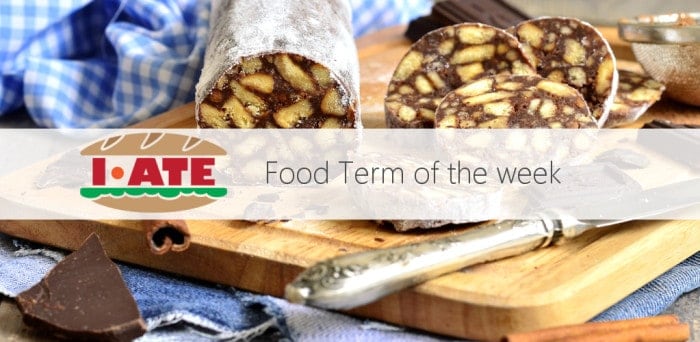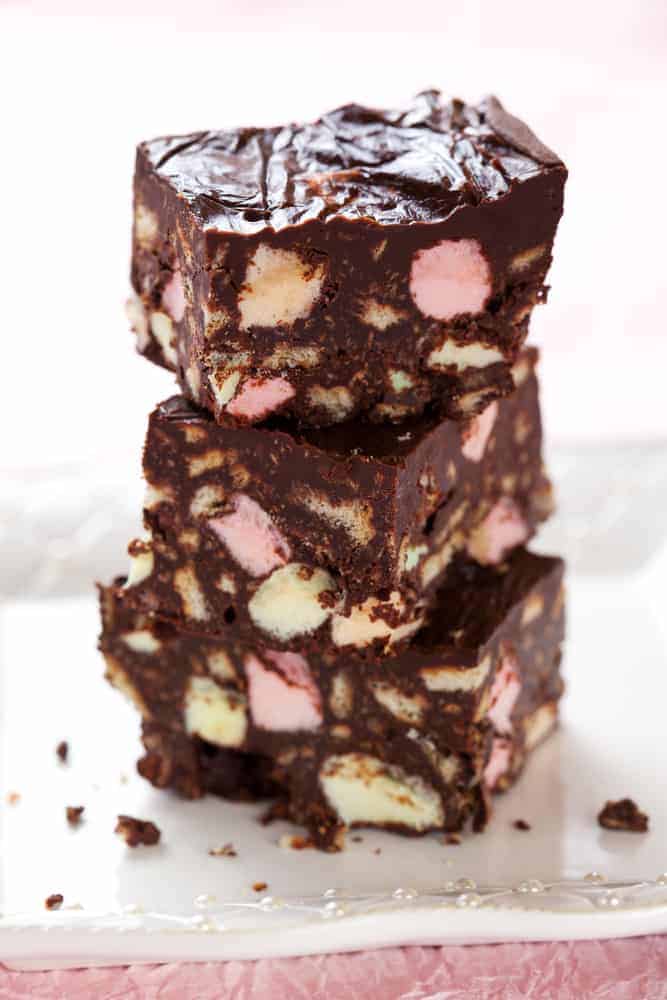Since I moved abroad I experienced that one of the best activities to socialise is eating! Dinners are a pleasant and funny way to get to know foreign cultures and especially culinary traditions. It was indeed an international dinner when I found out that my dessert was not unique to the Italian cuisine as I had thought until then. On the contrary, the dessert is known and prepared in other countries too.
Which dessert am I referring to? … The Italian ‘salame di cioccolato’!

Its popularity is linked to the ease and speed of preparation and the cheapness of the ingredients required to make it: biscuits, butter, sugar, chocolate powder and eggs are all you need to prepare it! No need to cook the dessert either. It is served cold after few hours of refrigeration and finally sprinkled with icing sugar. The name derives from the resemblance of the salame di cioccolato to its original savoury version. The same recipe is shared by the Portuguese cuisine, where the dessert is called ‘salame de chocolate’. Some versions also contains a bit or port wine or rum. 
The English literal translation of this no-bake treat is ‘chocolate salami’. However, its well-known version in the Anglophone world is ‘rocky road’. You can find it in England, Ireland, United States and Australia with slight variations. A common denominator are the marshmallows, used to replace the eggs of the Italian recipe and ‘stick together’ the rest of the ingredients. In the US, not only eggs but also biscuits are replaced, with walnuts or almonds. Similarly, the Australian cake is made up of additional ingredients such as desiccated coconut, glacé cherries, peanuts, and Turkish delight (a traditional Turkish jelly candy).
Very curious names are given to the cake in some Northern European countries. That’s the case of the Lithuanian ‘tinginys’, which literally means ‘lazy’. It is believed that, a woman accidentally created this dessert. While she was cooking chocolate, she added too much sugar at the point to obtain a syrup. Trying to fix it, she broke some biscuits into pieces and added them to the mix, which, once cooled off, resulted to be a cake. Because the recipe is so quick and easy to make, people decided to call the cake tinginys, since even the ‘laziest’ person can prepare it!
 A wacky name is also the German ‘kalter hund’, which means ‘cold dog’. There is no agreement on the origin of the name. It seems that, because the dessert tends to get a layer of condensation on its surface after being refrigerated for hours, it reminds of the wet and cold snout of a dog. This recipe includes eggs, cocoa powder, coconut oil, biscuits, vanilla sugar and a taste of rum. Its neat stratification of biscuits is loyal to the well-known German precision. This chocolate cake reaches even the warmer Mediterranean countries of Greece and Cyprus. In Greece, it is named either ‘kormos’, which means ‘tree log’ because of its shape, or ‘mosaiko’ (‘mosaic’) for the patterns you can see on the slice when the dessert is cut. As the Portuguese and German ones, also the Greek dessert contains a bit of alcohol since brandy is used to dip the biscuits in. The Cypriot ‘doukissa’ adds to the traditional recipe syrup, simply made with sugar and water, and drinking chocolate to stick all the ingredients together, and roasted almonds to give the cake a crunchy note.
A wacky name is also the German ‘kalter hund’, which means ‘cold dog’. There is no agreement on the origin of the name. It seems that, because the dessert tends to get a layer of condensation on its surface after being refrigerated for hours, it reminds of the wet and cold snout of a dog. This recipe includes eggs, cocoa powder, coconut oil, biscuits, vanilla sugar and a taste of rum. Its neat stratification of biscuits is loyal to the well-known German precision. This chocolate cake reaches even the warmer Mediterranean countries of Greece and Cyprus. In Greece, it is named either ‘kormos’, which means ‘tree log’ because of its shape, or ‘mosaiko’ (‘mosaic’) for the patterns you can see on the slice when the dessert is cut. As the Portuguese and German ones, also the Greek dessert contains a bit of alcohol since brandy is used to dip the biscuits in. The Cypriot ‘doukissa’ adds to the traditional recipe syrup, simply made with sugar and water, and drinking chocolate to stick all the ingredients together, and roasted almonds to give the cake a crunchy note.
Finally, if you are passing by some Eastern European countries you could taste a slice of chocolate salami. The cake is prepared in Bulgaria and Hungary, where it is respectively called ‘сладък салам’ and ‘csokoládészalámi’. The recipes are similar to the traditional Italian one with the exception of eggs, which are not included, and the addition of nuts.
Written by Giulia Mattoni, Terminology Trainee at TermCoord
Sources
- Creative-Ispiration. 2017. Baltic Run -The Most Delicious Lithuanian Desserts. Available at: http://www.balticrun.com/the-most-delicious-lithuanian-desserts/.
- Doukissa. 2017. Chocolate flavoured Biscuit Cake. Available at: http://www.tastecyprus.com/doukissa-chocolate-flavoured-biscuit-cake/.
- German Deli SCA. 2017. Recipe for Kalter Hund. Available at: http://www.germandeli.com/Recipe-for-Kalter-Hund-2.
- German Recipes. 2017. Chocolate Cookie Cake – German Cake Kalter Hund. Available at: http://www.mybestgermanrecipes.com/chocolate-cookie-cake/.
- Hellenic Grocery 2017. “Great” Kormos – Desserts – Homemade. Available at: https://hellenicgrocery.co.uk/homemade/desserts/great-kormos.html.
- iFood.tv. 2017. Chocolate Salami. Available at: http://ifood.tv/sausage/chocolate-salami/about.
- Le Ricette di Giallo Zafferano. 2017. Ricetta Salame di cioccolato. Available at: http://ricette.giallozafferano.it/Salame-di-cioccolato.html.
- My Greek Dish. 2017. Mosaiko recipe (Greek Chocolate and Biscuits Dessert). Available at: http://www.mygreekdish.com/recipe/mosaiko-greek-chocolate-and-biscuits-dessert/.
- Wikipedia. 2017. Chocolate salami. Available at: https://en.wikipedia.org/wiki/Chocolate_salami.
- Wikipedia. 2017. Rocky road (dessert). Available at: https://en.wikipedia.org/wiki/Rocky_road_%28dessert%29.
